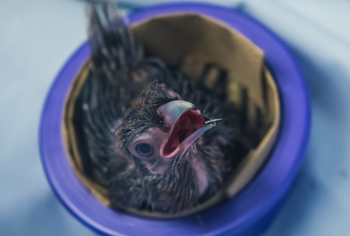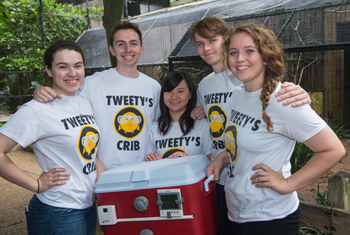Rice engineering students build cozy home for baby birds at Houston Zoo
Cartoon character Tweety Bird was never far from trouble, due to the conniving cat, Sylvester, but Granny was always close by to protect her beloved pet from harm.

A chestnut-breasted malkoha stays warm inside its brooder box constructed by Rice engineering students. Photo credit: Jeff Fitlow.
For all of the “Tweety Birds” out there who don’t have an overprotective Granny, there’s Tweety’s Crib, a group of five freshman engineering students from Rice University who spent last semester working with the Houston Zoo to create an inexpensive home for exotic baby birds in need of protection.
Tweety’s Crib members Justin Bernard, Elizabeth Peacock, Cade Ritter, Gina Wang and Kelsi Wicker worked at Rice’s Oshman Engineering Design Kitchen to replicate one of the zoo’s brooder boxes, which are designed to keep baby birds that cannot live with their parents safe and warm as they mature. The students built the project as part of the Introduction to Engineering Design course under the supervision of Ann Saterbak, a professor in the practice of bioengineering education, and Gary Woods, a professor in the practice in computer technology; they collaborated with Steve Howard, senior keeper in the Houston Zoo’s Bird Department.
The brooder was built using a standard beverage cooler and is heated with a fan. Humidity is controlled with adjustable air vents that do not allow light in. In addition, the box’s humidity and temperature can be monitored remotely. If either fluctuates excessively, an alarm sounds to warn the keeper. The box’s power system defaults to a 110-volt plug with an adapter for a 9-volt car jack, which allows the box to be easily transported to and from the zoo.
“Because the birds require so much care, the zookeepers must be able to take them home, which is why they need a reliable, portable, temperature-controlled and monitored system to sustain the baby birds until they mature,” Peacock said.
“The great thing about this is how self-contained it is,” Howard said. “The birds go home with us at first when they need to be fed all night long. We can bring it back and forth easily.”
The students said that one of the benefits of the box’s design is that all the parts can be replaced individually; as a result, if one part quits working, it doesn’t render the entire product useless.
“It’s easily reproducible, and all the parts can be bought online,” Wicker said. “You can take one piece out of any part of it and you can replace it. It’s not difficult to repair, and costs only about $250 total to build a new one.”
“This team worked very hard to deliver a high-quality solution to the keepers at the Houston Zoo,” Saterbak said. “As a team, they worked well together and got the project finished on time.
Bernard said the opportunity to help the zoo’s baby birds was amazing.
“When we delivered the final product and saw the bird that was going to go into the box we had just finished making, that changed everything,” he said. “It made it feel so real and completely worth all the work that we did.”


